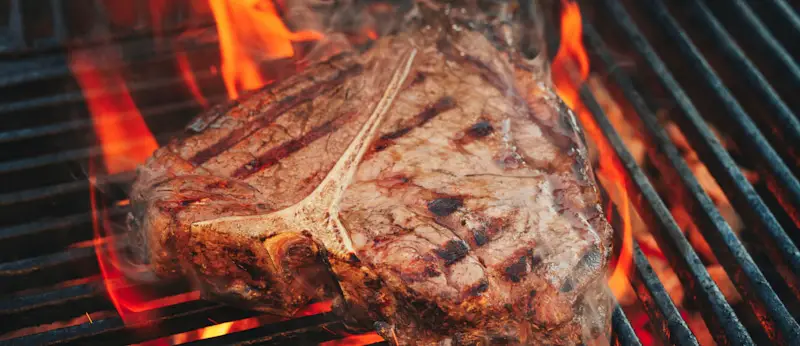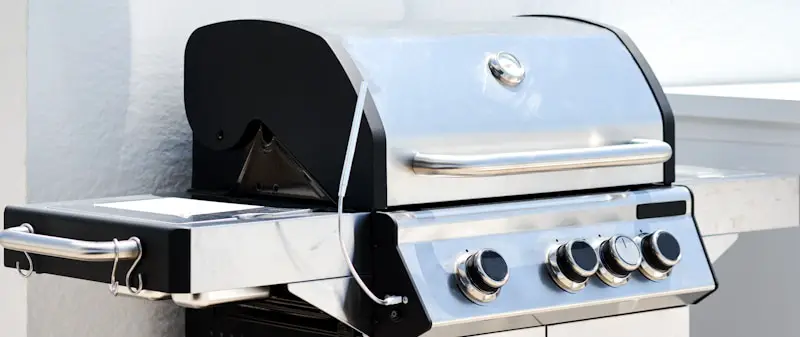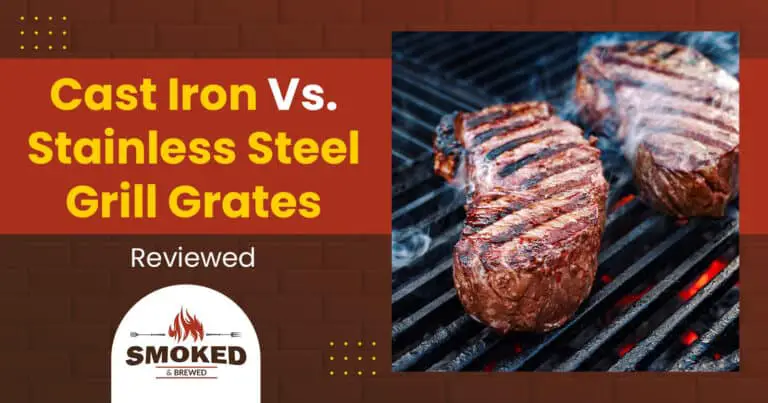Grilling is a great way of adding some extra smoky flavor to your favorite food. But when it comes to choosing the best grill and adding the best flavors, the choice of the cooking surface plays a significant role. After all, it is the grill grate that is in direct contact with the food, and the quality of these grates can definitely affect how your food cooks.
Cast iron grill grates are the conventional choice for professional-level grilling. When seasoned regularly, these grates offer enhanced flavors, higher heat retention, and long-lasting durability. On the other hand, high-quality stainless steel grates require less maintenance and are fairly durable for the price. The latter is best for quick grilling and easy handling.
From hamburgers, hot dogs, grilled fish or chicken to pizza, vegetables, or fruits, cooking over a good-quality grill grate that’s easy to use and maintain is probably a dream of every grillmaster. Most grill grates that are available in the market are made of cast iron, stainless steel, or ones covered by an enamel coating. To make it an obvious choice for you, the following is a detailed discussion on the differences, pros and cons, and the best-in-class cast iron vs. stainless steel grates.

What Is A Cast Iron Grill Grate?
Cast iron grill grates have been used as a cooking surface for hundreds of years. Most restaurants and professional grill masters would always choose a cast iron grill grate over stainless steel. If you are properly using a cast iron grate and seasoning it after every use, it is destined to last for years to come.
While pure iron is quite soft, cast iron contains about 2 to 4% carbon and other elements such as manganese, silicon, and sulfur. This makes it extremely hard and durable. Cast iron grates are available in two forms:
- Non-coated – These are extremely durable, hard and have a black-colored porous surface with a slightly rough texture. However, these are brittle and prone to rusting.
- Porcelain Enamel Coating – Most modern grills are equipped with cast iron grill grates coated with porcelain enamel which provides a non-stick surface and a more durable and smooth finish. The finish may be of any color.
When you are grilling your favorite food, searing can be an important task. Since cast iron grates retain better heat than stainless steel grates, the sear marks are far more beautiful and consistent with these grates. With more efficient heat transfer, the overall cooking time is also reduced with cast iron grates.
Pros Of Cast Iron Grill Grates
- Enhanced flavors and caramelization.
- Great for searing.
- Can last for a lifetime with proper care.
- Higher heat retention.
- Free of any chemicals that could transfer to the food.
- Cast iron grates with porcelain coating provide better non-stick qualities.
- Great for cooking both thin and thick cuts of meat.
Cons Of Cast Iron Grill Grates
- Cast iron grills are prone to rust, scratches, and damage with usage and exposure to the atmosphere. They especially oxidize in humid weather. If the cast iron grill is not coated with porcelain, the surface remains porous and absorbs grease and fats from the food.
- More expensive than stainless steel grates.
- They are heavy, which especially becomes cumbersome if you have to shift them around with charcoal beneath the grill.
- Requires extra effort to season and clean.
- If you accidentally drop the grill, the porcelain coating may crack. These enamel-coated grates can also form hairline cracks due to scraping, brushing, cleaning, etc.
Best Grills With Cast Iron Grates
- Weber Spirit II E 210
- Char Broil Performance 475
- Char Broil Performance Series Amplifier 4 burner gas grill
- Cuisinart CGG 7400
How To Maintain Cast Iron Grill Grates
For first-time use, wash the cast iron grill grate with warm water and then dry it with a paper towel. Brush the grate with cooking oil (preferably vegetable oil or bacon fat). Next, place it in a 400 degrees Fahrenheit oven for about an hour and wait until it cools down naturally. This process is called ‘seasoning.’
Once the grilling session is complete or the grates look super messy, you must scrape off any food debris from the grates with a brush or scraper. It is recommended to re-season the grates after every use. Try not to use soap for your cast iron grill grates.
When the grates are not in use, make sure to keep them away from moisture. If you need to store them for a longer period, then coat them heavily with cooking oil and store in plastic wrap.

What Is A Stainless Steel Grill Grate?
Stainless steel grates are made of chromium, carbon, and other alloying elements. The resistant power of stainless steel grates can be enhanced by adding nickel, molybdenum, titanium, etc.
Stainless steel is often equipped in entry-level grills to lower the cost. They are lightweight and a great choice for those who are looking for a portable grill. Though stainless steel does not retain high heat, the thinner surface makes the grill heat up quickly.
Not all ‘silver’ looking grates are stainless steel. Regular, steel-plated, or cheap-quality steel grates cannot withstand high heat and are unsuitable for grilling. It is also important to note that stainless steel isn’t 100% corrosion-proof. Though stainless steel grill grates usually last for many years, layers of steel can corrode on contact with chloride ions (present in table salt), high temperatures, acids, or lack of oxygen on the surface.
Pros Of Stainless Steel Grill Grates
- Easier to maintain and clean than cast-iron grates.
- Heats up quickly, which ensures faster cooking.
- Lightweight and thus easier to move even when the grate is still hot and greasy.
- Cheap.
Cons Of Stainless Steel Grill Grates
- Low-quality stainless steel grates are prone to rust.
- Low heat retention.
- May bend or warp or show signs of discoloration with usage.
- Though they are long-lasting, they are not completely corrosion free and can wear and tear over time.
- Cannot cook thin slices of food efficiently.
The Best Grills With Stainless Steel Grates
Stainless steel is usually bought as a replacement or as an extra accessory for your grill station. They are readily available with most brands, such as Weber and Char Broil. Some of the best grills with stainless steel grates are
How To Maintain Stainless Steel Grates
Unlike cast iron grates, stainless steel requires minimal care. Once the stainless steel grate has returned to its normal temperature, you can use a mild dishwashing soap and a metal scrubber/ steel wool/ abrasive cleaner to remove any food debris and then wash with water. You may also use baking soda to preserve the shine of the grate.
Stainless steel should not be put to very high heat as it can cause discoloration.
Summary
To conclude, here is a comparison chart for some of the key differences between Cast Iron and Stainless Steel Grates:
| Characteristics | Cast Iron Grill Grates | Stainless Steel Grill Grates |
| Finish/ Color | Non-coated – Rough / Black, Coated – Smooth & Shiny / Any color | Smooth / Silver |
| Non-stick surface | Lasts for a lifetime with regular seasoning. | Loses over time |
| Heat Retention | Very High | Low |
| Searing/ Grill Marks | Prominent | Average |
| Prone to rusting | Yes | Rare |
| Heating Speed | Slow | Quick |
| Durability | High | Low to Medium |
| Maintenance | High | Medium |
| Weight | Heavy | Light |
When buying a new grill grate, it is important to consider the type of food being cooked. Today, most grills come pre-equipped with cast iron grates. However, if you need to replace them, you can either buy the same version from the brand, or if your model supports it, you can choose a stainless steel alternative. Whatever it takes, you should never compromise on the quality of your grill grates.
Happy grilling!
Scot has loved smoking food in his free time for the last few years. Each major holiday or off-weekend, Scot spends days testing and prepping new recipes for perfection.

